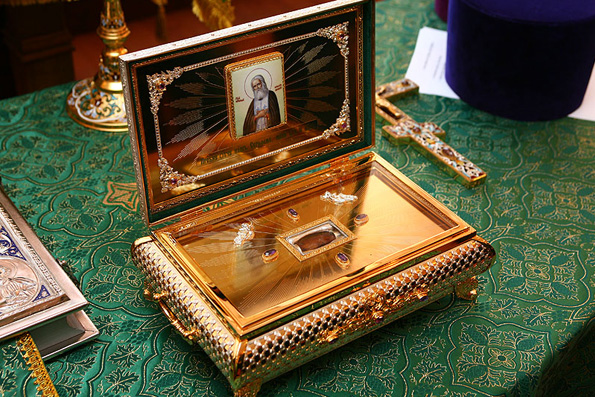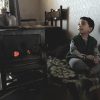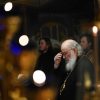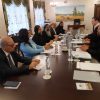By Schema-Archimandrite Sergius, abbot of Saint Tikhon’s Monastery
On the topic of “Orthodox Living in the Modern World: Steps to Spiritual Transformation”.
Christ Himself, when the Apostles asked Him, “Where do You live,” says, “Come and see.” And then when the Disciples are telling other potential disciples about the Lord they simply say “Come and see.” That’s the most important part of our faith, that it’s so real and tangible. Pilgrimage is part of that experience. It’s about being able to encounter God in a very immediate and a very close way that’s very transformative and inspires us and renews us, giving us hope and life.
The holy relics of Saint Nicholas are located underneath the altar. I was just in Saint Nicholas Church in Bari, Italy where Saint Nicholas of Myra in Lycia is. Sometimes we don’t realize that the Saints are so powerful that even in the midst of a society that rejects Saints, and the Church, and even the Lord, still the power of Saint Nicholas is coming up through the ground and manifesting itself in our society in a very profound and real way. Saint Nicholas knows everything we’re thinking, whether it’s naughty or nice and he can see and knows what’s going on, because he is united with God and that means he’s everywhere. He’s still working tirelessly. Going to encounter that great Saint in Bari was such a blessing and it reminded me of the critical place of pilgrimage in our life. I was renewed in that it is very important for us to experience these things and be changed by these things. You can go and touch Saint Nicholas. They have myrrh that comes out of his tomb that they collect once a year. It’s beautifully smelling white myrrh that they mix with water to give to pilgrims.
Encountering this powerful intercessor, I am reminded of the universality of our Church and the importance of encountering our faith in a very real way. What is the center of our faith if not the Eucharist? We taste and see that the Lord is good. The Church addresses every sense. Every part of us is engaged by the Church if we allow it to be. The Church wants to sanctify every single part of us, every single molecule.
An incorrupt Saint is by the by-product of that sanctification process. The Holy Spirit dwells in people so much that even their body doesn’t decay anymore. Our body is a very important part of the whole process of salvation. It’s a reality that we need the body to actualize our works of repentance. Not all Saints are incorrupt, but it is a sign of the indwelling of the All-Holy Spirit which keeps us together, not only in soul and body, sometimes in so much superabundance that these Saints remain incorrupt, awaiting the Second Coming of Christ.
I was just reading the words of Christ this morning that, “And whosoever liveth and believeth in Me shall never die” (St. John 11:26). “Never die.” That’s the main enemy, as Saint Paul says. He says that that last great enemy to be conquered is death. That’s what Christ comes to address, that we might have life, and more abundantly. Superabundant life it says in the Greece, and so these Saints who are so filled with that life don’t decay.
Reliquary of Saint Spyridon, Across from Bari is Corfu (Kerkyra), where are the incorrupt holy relics of Saint Spyridon, which are not just incorrupt in the typical way. They say that they actually have to change his worn-out shoes every few months because he’s out and about doing things. You may kind of laugh and think that’s very strange, but once Archbishop Benjamin (Orthodox Church in America) was telling stories about Alaska, and he told us that when they canonized Saint Herman (Germanos) in 1970, many of the natives did not know that he had died, because he was still active. He’s still working. If they die in the Lord they never see death. (On Facing Ourselves )
The Holy Fathers of the Church say that when we die the only thing we can take with us is that which we have given away, and even more importantly we take the disposition of our heart. Was it oriented towards God and the good things of life and love, or was it oriented towards ourselves, which is, in a way, death? What was the principal movement of repentance in the parable of the prodigal son? “He came to himself.” He had forgotten himself. There is no movement towards God that doesn’t start with moving back to myself. Spiritual life is always a movement to the heart and then to God because I can only speak to God “from the heart.”
Our prayers are sometimes not answered because we pray like a talking head disconnected from our heart: “I want this, I want that, please help me, help me…” and therefore He doesn’t hear them. We have to come to ourselves every time we go to pray. The reality of the Fall is this: a movement away from ourselves out to the created world–cars, family, boat, worries about jobs, even about good things like Church. This movement away from the heart gets us so distracted and scattered that we have nothing of true content to offer, and we feel so frazzled sometimes.
One of the most important things we can do in this life is to make time for God which is really time to come back to ourselves, to our heart, because this is the first movement and if we don’t realize the first movement then the second movement, back to God, cannot happen. The movement back to the heart is a movement to my own self, and sometimes we don’t want to face this because it’s so difficult, ugly and scary. Me.
The hardest thing to face is the truth about ourselves. It’s really hard. We pay entertainers hundreds of thousands of dollars every year to distract us from ourselves, and from the reality that this world is dying. It’s sad but true. It’s because we don’t want to face the reality of ourselves and by extension our lives, which might be dysfunctional or have problems. It’s much easier to run to pseudo supports instead of real support.
As we get older, the tendency is to continue receding away from people, back into ourselves, becoming more isolated. It’s weird but that’s the reality because we don’t like pain. It’s a very difficult reality to face sometimes. But how do we cope with pain? Unfortunately, we go the wrong direction–we go back to pleasure. And then we get stuck in this vicious cycle of pain and pleasures, and it’s this never-ending wheel that we’re stuck in like a hamster until our last days.
The most important component of Orthodox Christianity is that Jesus Christ is the Logos/Word made flesh, and this Logos/Word is eternal. There was never a time when Jesus Christ was not. We live in time, and therefore we have a sense of past, present, and future, but in God there only is. God just is. Jesus Christ is God and He always was and He always will be. Saint John says in his epistle (letter), “this is the victory that overcomes the world”–by your faith, by the power of the Holy Spirit working in your heart you understand that Jesus Christ really is Who He said He was.

















